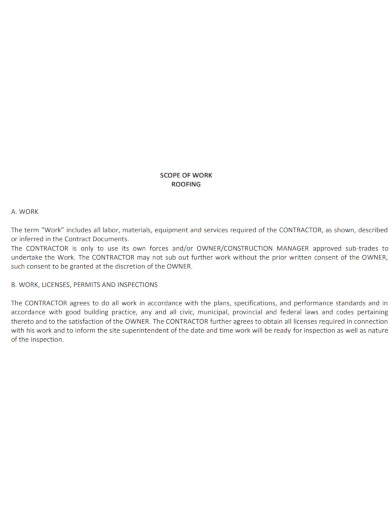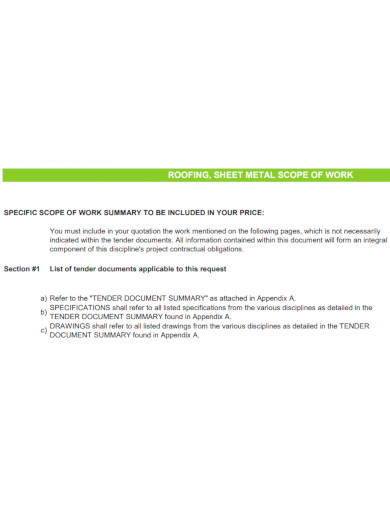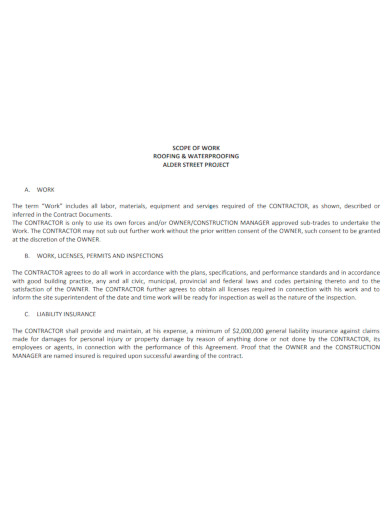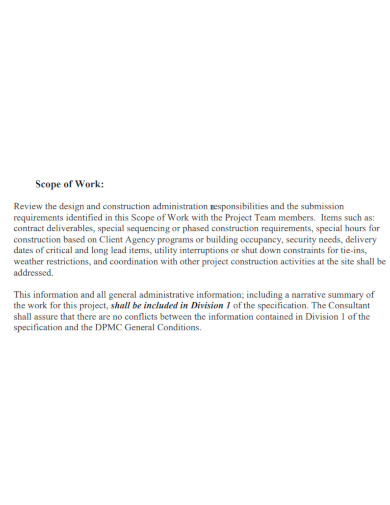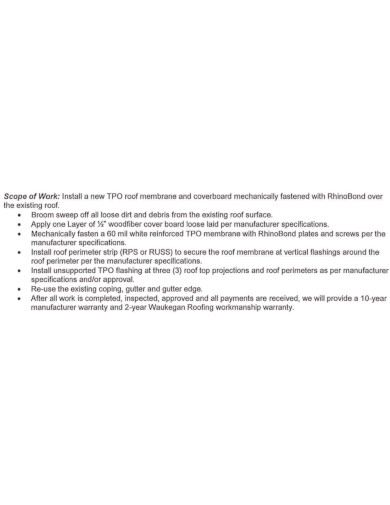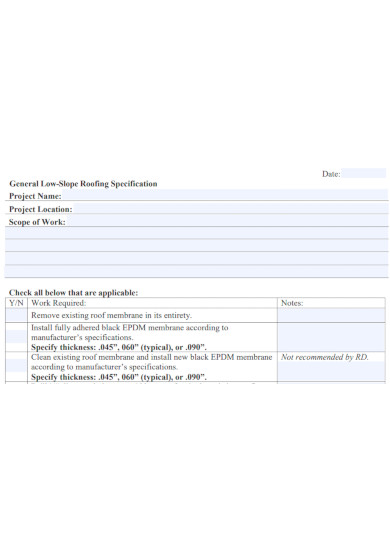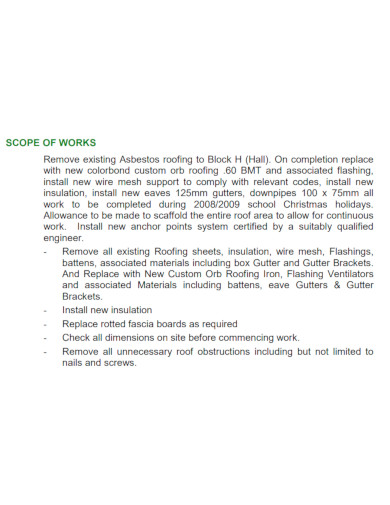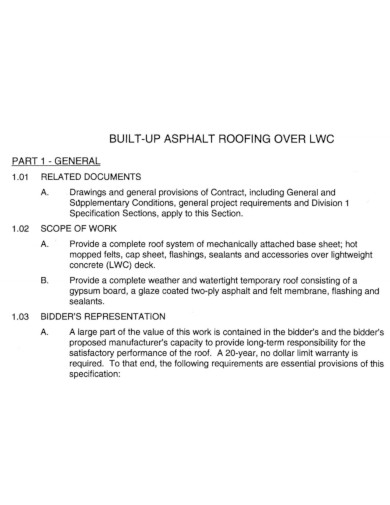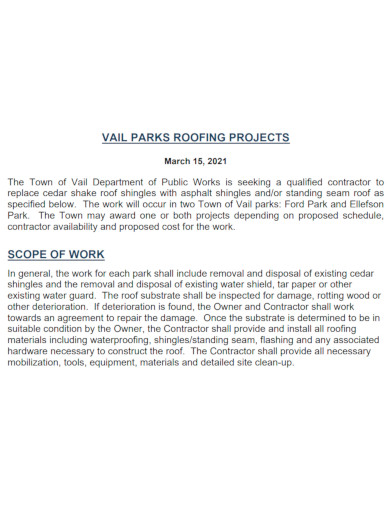Although most people don’t realize it, a roof is an important aspect of a building. It serves as a shield to buildings from extreme weather conditions that could destroy the building. It could also serve as insulation to keep people warm during the cold season or cool during the hot season. So if a roof is damaged, it is a big concern that must be fixed right away. And so, roofers are called to construct and fix roofs to ensure roofs are stable and waterproof. They also install insulation systems and vapor barriers to control the temperature inside the building. A roofer’s job is usually different from one client to another and that is why they need a scope of work to describe their particular job to do for a client. Read the article to find out how to make a roofing scope of work.
10+ Roofing Scope of Work Samples
1. Roofing Scope of Work Sample
2. Metal Roofing Scope of Work
3. Roofing and Waterproofing Scope of Work
4. Project Roofing Scope of Work
5. Editable Roofing Scope of Work
6. Professional Roofing Scope of Work
7. Formal Roofing Scope of Work
8. Roofing Scope of Work Format
9. Basic Roofing Scope of Work
10. General Roofing Scope of Work
11. Strategic Roofing Scope of Work
What is a Roofing Scope of Work?
To understand the roofers’ work in general, one must know what a roofer is. A roofer is basically the person responsible for building, fixing, and maintaining roofs. Most roofers specialized either in residential or industrial roofing or both.
Scope of work is a formal document in which a written agreement is done by both the contractor (in this case, the roofer) and the client where the type of work to be done is described. It encompasses the deliverables, and work description of the services the contractor will provide to the client.
How to Make a Roofing Scope of Work
For roofers, the scope of work must provide accurate details of the work to be done for their clients including the specified materials needed for the job. Below is the format of a roofing scope of work:
1. Background Information
The first part of the work is a summary of the background of the roofer’s business details and their client’s details. This is also where the scope of work shows that the roofer and the client agree in doing roofing work will be done in the client’s area.
The next part may not be necessary to add but if needed, add a definition subheading of the definition of terms if there are some terms, such as jargon, that are not generally understood but are going to be mentioned frequently in the scope of work.
2. Background of Work to be Done
This part is where a brief explanation of the reason why the roofing work is done in the first place. It could be the roofer is installing roofs or repairing roofs in the client’s building. You will then transition on to putting a detailed introduction of the work to be done. You could give an explanation of the client’s current roof condition and the solution the roofer has come up with to fix the problem. Include also the accurate total square footage and description of the roof’s work area.
3. Work Description
The next part is to state the specific roofing work to be done for the client. To give context, here are some examples of the duties and responsibilities of a professional roofer:
- Build roofs using various materials depending on the roof type,
- Inspect damages and repair them,
- Remove debris from roofs to place materials,
- Smoothen roof surfaces and fill in edges with cement,
- Build roofs using various materials and tools
- Ensure roofs serve their purpose such as protecting buildings from weather conditions,
- Removal and disposal of an old roof,
- Set up vapor barriers and vents
- Install insulation and solar energy systems,
- Restock roofing materials, such as clay and cement.
Include also the type of roofing materials you need, the manufacturer, and the color selection for all roof replacement components.
4. Objectives
The next part is the objectives, where you will describe the goals the roofers should achieve on the job. An objective could describe that the roofer “must ensure the rooves are installed in all apartment complexes two weeks before the occupants move in”, or “ensure the rooves are fixed and free from leaks.”
5. Deliverables
The deliverables will determine the expected outcome of the roofing job. The deliverables must be the result of the work being done.
6. Schedule
Roofers must ensure their work is delivered on time. To achieve this, there should be a timeline of when the job will start and end. The schedule is where you put the day and time when the roofing job will begin and end. Include also the duration of the job like how long will the roofer work in a day and how long will the roofing job be done.
7. Payment
Lastly, the payment will be emphasized on the scope of work. Put the schedule of when you’re getting paid for your services and the materials and tools you used in your work. Putting the amount is not necessary to add but you can add how you want to be paid by the client. This must be discussed with the client first before putting it into writing.
FAQs
How much does a roofer charge per day?
A roofer’s job is one of the most difficult and most dangerous jobs. Professional roofers may charge around $300 per day to construct or fix a roof. However, their prices will vary on what type of work they will do for their clients.
What are the different types of roof designs?
There are countless roof designs present right now. Here are some examples of roof designs: saltbox roof, mansard roof, gambrel roof, pyramid roof, hip roof, and flat roof.
What skills does a roofer need?
A roofer must have strength, balance, stamina, and no fear of heights to be able to work effectively on building, installing, and repairing rooves.
Once the scope of work is written, make sure it is free from grammatical and spelling errors. It must look presentable and formal to show that you mean business. Show the revised scope of work to your client to discuss it further. Make sure before you start your job with the client, you both reached a mutual agreement on your scope of work. To help you get started on making your scope of work, why not use our sample free scope of work templates above? You can easily download these templates and they are also editable and printable too so download one now!
Related Posts
Sample Meeting Minutes Templates
Presentation Speech Samples & Templates
Ukulele Chord Chart Samples & Templates
Retirement Speech Samples & Templates
Weekly Schedule Samples & Templates
Contractual Agreement Samples & Templates
FREE 9+ Amazing Sample Church Bulletin Templates in PSD | PDF
Sample Business Card Templates
Sample Cashier Job Descriptions
Questionnaire Samples
FREE 10+ Sample HR Resource Templates in PDF
FREE 10+ HR Consulting Business Plan Samples in MS Word | Google Docs | Pages | PDF
FREE 49+ Sample Job Descriptions in PDF | MS Word
FREE 16+ Nonprofit Budget Samples in PDF | MS Word | Excel | Google Docs | Google Sheets | Numbers | Pages
FREE 13+ Academic Calendar Templates in Google Docs | MS Word | Pages | PDF

